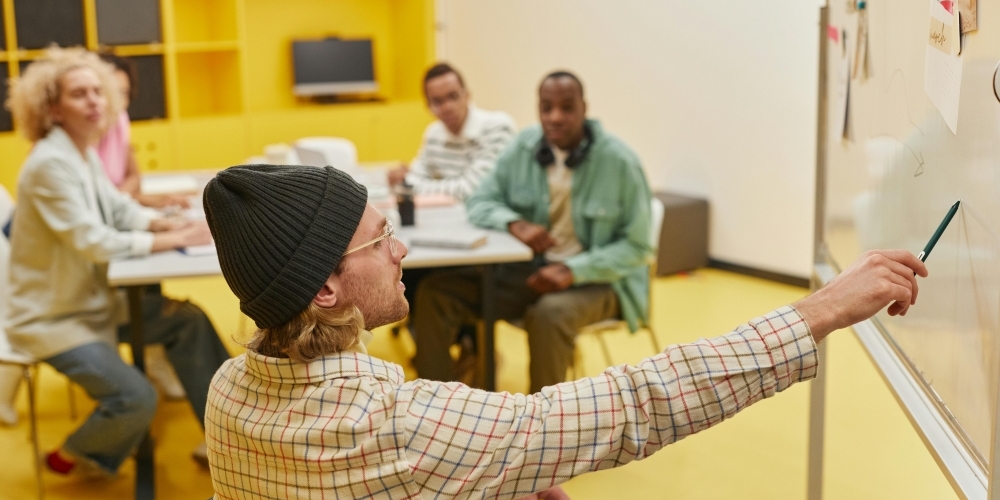- 首頁
- 部落格
- Woody的數學深度漫談
- 高中數學「數與式」教學改革(下):科技整合、評估革新與教師支持

高中數學「數與式」教學改革(下):科技整合、評估革新與教師支持
但課堂的轉型不只來自教學策略,更是來自工具的革新!當科技進入教室,老師不再只是講解者,學生也不再只是聽眾——他們可以操作、模擬、建構,甚至在虛擬空間中「走進」數學。我們將透過本文接續討論數學學習的生活化,並延伸到對學生數學能力評估的革新,與教師專業成長的支持。
讓數學走出課本:從生活問題開始學習
數學不只是考試裡的題目,它其實每天都在我們身邊。我們可以從學生熟悉的生活情境出發,設計像「建築模型比例設計」「家庭預算規劃」這樣的任務,讓學生在解決真實問題的過程中學習數學。透過跨領域的專題活動,學生不只學會計算,更能理解數學在工程、科技、甚至藝術中的角色。邀請業界專家進教室分享,也能讓學生看到數學的職場價值,提升學習動機。
把數學融入科技與工程:STEM教學這樣做
STEM 教學不只是把四個科目放在一起,而是透過有意義的整合,讓學生在解決問題時自然運用數學。像是在設計太陽能屋頂時,學生需要計算面積、角度與成本,這些都需要數學建模與邏輯推理。教師可以設計跨科專題,讓學生在動手做中學習數學,並培養團隊合作與創新能力。這樣的學習方式不只更有趣,也更貼近未來職場的需求。
從問題到公式:教學生如何建構數學模型
數學建模是一種把真實問題轉化為數學語言的能力。我們可以從簡單的生活問題開始,例如「怎麼安排最省時的交通路線」,再逐步引導學生處理更複雜的議題,如「人口成長對資源分配的影響」。教師可以設計開放式任務,讓學生經歷整個建模過程:分析問題、建立假設、構建模型、驗證結果、詮釋意義。這不只是學數學,更是在培養系統思考與批判能力。
不只看分數:用多元方式了解學生的數學能力
傳統的紙筆測驗只能評估學生的計算能力,但現代數學教學更重視思考過程與概念理解。我們建議採用多元評估方式,包括觀察、對話、作品分析、自我與同儕評量等,讓學生的學習歷程被完整記錄。教師也可以運用數位工具建立學習歷程檔案,即時掌握學生的學習狀況,調整教學策略。這樣的評估方式不只更全面,也更能支持學生的個別發展。
邊學邊評:用回饋引導學生成長
形成性評估強調在學習過程中即時給予回饋。老師可以透過課堂觀察、學生作品、討論紀錄等方式,了解學生的理解狀況,並適時調整教學。設計自我評估與同儕評估活動,也能讓學生學會反思與批判,培養自主學習能力。這種「學習中評估」的方式,比起考試更能促進深度學習。
不只會算,更要會想:如何評估數學思考力
數學不只是算出答案,更重要的是「怎麼想出來的」。我們建議設計開放性問題,讓學生展現推理過程與策略選擇。評估時可以從概念理解、程序流暢性、策略應用、適應性推理等面向進行分析,透過多元證據了解學生的數學思維發展。
用真實任務看學生怎麼用數學解決問題
想知道學生是不是真的懂數學?不妨讓他們試著解決真實問題。像是設計一個小型展覽預算、規劃校園空間配置,這些任務都能讓學生運用數學知識。教師可以建立數學作品集制度,讓學生整理自己的學習成果,從中觀察他們的成長軌跡與思維變化。這樣的評估方式不只更貼近現實,也更能激發學生的學習動力。
讓老師也持續成長:打造支持型教學社群
當然,教學改革不只是學生的事,老師的成長同樣重要。我們希望透過建立教師學習社群,讓老師能夠彼此交流、分享教學經驗、共同設計課程。這樣的合作不只提升教學品質,也讓老師在教學路上不孤單。教師也需要新的教學知識與理念,像是建構主義、差異化教學、科技整合等。透過工作坊、線上課程或行動研究,老師可以逐步轉型,從「知識傳授者」變成「學習促進者」。
教學理念升級:讓數學課更貼近學生
現代數學教育強調理解、應用與溝通,老師也需要重新認識數學教學的核心價值。我們鼓勵教師參與專業培訓,學習如何設計探究式課程、如何引導學生進行數學對話、如何評估學生的思考過程。這些知能不只是理論,更是實務操作的基礎。當老師掌握這些方法後,就能設計出更有深度、更有溫度的數學課程。
科技教學不難:老師也能輕鬆上手
數位工具已成為教學的好幫手,但許多老師仍在摸索如何有效使用。我們建議提供實用的培訓課程,教老師如何操作 GeoGebra、Desmos、線上互動平台等工具,並設計有趣的數位活動。重點不只是學會操作,更是學會如何「教得好」。透過模擬教學、案例分享與實作練習,老師可以逐步建立數位教學的信心與能力。
從小步開始,走向長遠願景:課程改革這樣推
教學改革不需要一次到位,可以從試點班級開始逐步擴展。在推動過程中,持續收集學生與教師的回饋,調整課程設計,才能讓改革真正落地。同時也需要行政支援與資源協助,像是提供教學時間、技術支援、教材資源等,讓老師能夠安心嘗試新方法。
一步一步來:課程更新的推動路線圖
我們建議分階段推動課程改革。第一階段先建立共識與試點;第二階段擴展實施並進行教師培訓;第三階段進行成效評估與優化。這樣的策略能夠降低風險,也讓改革更具彈性與可持續性。每個階段都需要明確的目標與支持系統,才能確保改革穩健前進。
讓數學教育真正為學生的未來打底
我們的最終目標,是讓學生具備21世紀所需的數學素養:推理能力、問題解決力、數學溝通力與科技應用力。這不只是為了考試,更是為了他們的未來生活與職涯發展。同時也希望建立一個能夠持續更新的課程體系,讓老師有專業自主性,能夠根據學生需求靈活調整教學內容。這樣的教育模式,才能真正支持學生的終身學習與全面發展。
結語:攜手打造更好的數學教育現場
在課程設計、教學策略、科技整合與評估革新的多方努力下,我們正逐步走向一個更貼近學生需求、更具未來感的數學教育環境。但這樣的轉型,絕非單打獨鬥所能完成——它需要一個支持系統,讓老師在教學路上不斷成長、不斷創新。而這也是我們創立「STOODY思無敵雲端教育」的初衷。我們深知,每位老師都是課程的設計師與引路人,而 STOODY也為老師們提供以下服務:
- 師資培訓:從課程設計到數位教學工具操作,協助老師掌握現代教育核心知能。
- 學習資源:提供可即時應用的教材、教學範例與活動設計,減輕備課負擔。
- 教學諮詢:一對一或小組形式的教學診斷與策略建議,讓老師在實務中找到解方。
我們相信,當老師擁有足夠的支持與資源,就能設計出更有深度、更有溫度的課程,真正為學生的終身學習與全面發展打下穩固的基礎。如果您也正在尋找教學上的靈感、資源或夥伴,歡迎加入 STOODY,一起讓未來的數學課,變得更有力量、更有前瞻性。

【Woody老師優質好文精選】
學測數A如何準備?高分關鍵技巧與讀書計畫方向總整理!
想學AI,先學好高中數學!線性代數與微積分如何成為人工智慧的關鍵?
高中數學如何為AI學習鋪路?機率統計、離散數學與實作建議,讓你成為AI高手!
戰勝排列組合(一):如何計算組合數C(m, n):從概念到實作,搞懂C的算法!
戰勝排列組合(二)如何計算排列公式P(m, n):「重複問題」的概念解釋及範例
文章參考資料來源:
- OECD (2024), An Evolution of Mathematics Curriculum: Where It Was, Where It Stands and Where It Is Going, OECD Publishing, Paris, https://doi.org/10.1787/0ffd89d0-en.
- Teaching Strategies for Improving Algebra Knowledge in Middle and High School Students, IES Practice Guide (April 2015)
- Mohammed Irshad, Enhancing Mathematical Literacy in School Students: Strategies for Effective Instruction in Basic Math Concepts, Sch J Phys Math Stat, Jan, 2024; 11(1): 1-5
- Celita Lewis-Davis, 6 Ways to Improve Students’ Math Literacy, edutopia
- Nursupiamin, Lilies N.Tangge & Afadil Afadil, DEVELOPING A CONSTRUCTIVISM APPROACH IN MATHEMATICS LEARNING, International Journal of Teaching and Learning (Vol. 2 No. 6 (2024): JUNE)
- CONSTRUCTIVIST TEACHING IN MATH, Accelerate Learning
- 39 Examples of Real-World Math Problems, DARTEF
- Teaching Math Through Real-World Problem-Solving, OdlesLearning
- N Srilatha & Dr.Asit Kumar Sen, REVIEW OF TECHNOLOGY-ENHANCED LEARNING IN MATHEMATICS EDUCATION, Journal of Nonlinear Analysis and Optimization, Vol. 15, Issue. 2 : 2024
- Sherine Menella St Omer, Katerina Evers, Chia-Yu Wang & Sufen Chen, Technology-enhanced mathematics learning: review of the interactions between technological attributes and aspects of mathematics education from 2013 to 2022, Humanities and Social Sciences Communications volume 12, Article number: 1079 (2025)
- Maria Blanton & Angela Murphy Gardiner, Developing an Effective Curriculum for Early Algebra, TERC
- Jordani Sarreal, Teaching Integrated STEM Education, Kid Spark Education
- Jodi B. Prideaux, The Constructivist Approach to Mathematics Teaching and the Active Learning Strategies used to Enhance Student Understanding, St. John Fisher University
- Saul McLeod, Constructivism Learning Theory & Philosophy of Education, Simply Psychology
- Patrick W. Thompson, Constructivism in Mathematics Education, Constructivism in Mathematics Education
- Ellen Ullman, 7 Strategies for Differentiated Math Instruction, HMH
- Joshua Walker, Math for All: Strategies for Differentiating Instruction in the Math Classroom, Linkedin
- Andrew Marks, Geoff Woolcott & Christos Markopoulos, Differentiating Instruction: Development of a Practice Framework for and with Secondary Mathematics Classroom Teachers, International Electronic Journal of Mathematics Education 2021, 16(3)
- Teaching Tuesday: Literacy in Mathematics Content Instruction, GCU
- Jeff Crayton, Four Best Practices for the Math Classroom, Achieve The Core
- Leading with Technology: Enhancing Mathematics for All Students, NCSM
- Hassan Hossein-Mohand, Hossein Hossein-Mohand, Veronica Albanese & María del Carmen Olmos Gómez , AI in mathematics education: A bibliometric analysis of global trends and collaborations (2020-2024), MODESTUM
- Sandugash Kappassova, Alma Abylkassymova, Ummugul Bulut, Symbat Zykrina, Zaure Zhumagulova & Nuri Balta, Mathematical literacy and its influencing factors: A decade of research findings (2015-2024), EURASIA J Math Sci Tech Ed, 2025, 21(7), em2671
- ICALT 2024
- Szu Chun Fan, Kuang Chao Yu & Kuen Yi Lin, A Framework for Implementing an Engineering-Focused STEM Curriculum, 國立台灣師範大學開放學者平台
- Danielle Dani, Courtney Koestler & Lizhen Chen, STEM Integration in Field Experience for Mathematics and Science Teachers
- Ann W. Linson & Dr. Rebecca Lamon, Enhancing K-12 Curriculum with STEM Integration, cognia
- Using Mathematics to Solve Real World Problems, Simon Fraser University
- Create Real World Maths Problems That Students Actually Want to Solve, redmenta
- Eleni Demosthenous, Constantinos Christou & Demetra Pitta-Pantazi, Mathematics Classroom Assessment: A Framework for Designing Assessment Tasks and Interpreting Students’ Responses, Eur J Investig Health Psychol Educ. 2021 Sep 18;11(3):1088–1106. doi: 10.3390/ejihpe11030081
- Laura Gini-Newman, Assessing Mathematical Thinking: A Focus on Reasoning Competencies, The Critical Thinking Consortium
- Teachers’ Guide: Assessing Reasoning, ASSESSING MATHEMATICAL REASONING
- Measuring Early Mathematical Reasoning Skills, SMU
- Demonstrate mathematical reasoning, NCEA Education
- Thinking and Problem Solving: Math in the Real World, Columbia University Pre-College Programs
- Angeline B. Vacalares, Carmelita O. Elbanbuena & Jovit D. Comon, Differentiated Instructional Practices and Academic Performance in Mathematics, EMSJ Vol.8, No.4-2024, DOI: https://doi.org/10.59573/emsj.8(4).2024.11
- Mathematics Education: Trends and Innovations, THAI BINH DUONG University
- Martínez Carranza, New developments and trends in mathematics education at upper secondary level, ICMI
- Yaroslav Chkana, Olena Martynenko, Artem Yurchenko, Igor Gorovoy & Olena Semenikhina, A bibliometric exploration of research in mathematics education (2020–2024) , EURASIA Journal of Mathematics, Science and Technology Education, 2025, 21(7), em2659
- Mullen, Jennifer, "Enhancing Mathematical Literacy" (2009). Mathematical and Computing Sciences Masters. Paper 90.
- High-Impact Instructional Practices in Mathematics | Resource and Supports, Ontario
- Hadrian Mei Fajri, Arita Marini & Suyono, Trends and patterns in realistic mathematics education research in elementary schools: A bibliometric approach, ScienceDirect
- Victoria Donohue, How to Choose the Best Math Curriculum, GRADUATE PROGRAMS
- Stephanie Barnett & Amanda Bikowski, How to Select a High-Quality, Equitable Math Curriculum, edreports
- Charlotte Cushman, Instructional Strategies for Mathematical Literacy, PATHS TO LITERACY
- Larry Ferlazzo, Response: Best Practices for Teaching High School Math, EducationWeek
- Language in Mathematics: Maths Literacy Strategies, ORIGO Education
- Paul A. Asunda, A Conceptual Framework for STEM Integration Into Curriculum Through Career and Technical Education, Journal of STEM Teacher Education 2014, Vol. 49, No. 1, 3–15
- Adeeb M. Jarrah, Yousef Wardat, Patricia Fidalgo & Nagla Ali, Gamifying mathematics education through Kahoot: Fostering motivation and achievement in the classroom, Research and Practice in TechnologyEnhanced Learning(2025) 20:10
- Integrated STEM learning, Australian Government Department of Education
- Cannon, M. A.(2017). Differentiated Mathematics Instruction: An Action Research Study. (Doctoral dissertation). Retrieved from https://scholarcommons.sc.edu/etd/4222
- Numerical Reasoning Tests: Guidelines & Practice Examples, MConsulting Prep
- Oliver Savill, Numerical Reasoning Test Guide: Our Top Tips, AssessmentDay
- Problem Solving in the Real World, the TEACHER Studio
- Nancy Ironside, Ensuring That Math Instruction Provides Opportunities for All, edutopia
- Alyson Klein, Ditch Those Math Worksheets. The Case for Teaching Real-World Problem Solving in K-5, EducationWeek
